Inverting the Concentrations of Chlorophyll-a and Chemical Oxygen Demand in Urban River Networks Using Normalized Hyperspectral Data
Abstract
1. Introduction
2. Data and Methods
2.1. Study Area
2.2. Water Sample Collection and Hyperspectral Data Preprocessing
2.3. Retrieval Models for Estimating Chl-a and COD Concentration
3. Results
3.1. Inversion Results of Chl-a Concentration
3.2. Inversion Results of COD Concentration
4. Discussion
4.1. Analysis of the Comparison of Model Performance Before and After Hyperspectral Normalization
4.1.1. Verifying the Model Performance Using Different Types of Hyperspectral Data
4.1.2. Testing the Model Performance Using the Same Type of Hyperspectral Data
- (1)
- If the original hyperspectral data remains unnormalized, it is advisable to use Rrs to construct the water quality inversion model. The results presented in Figure 4a–h, Figure 6a–h, Figure 8a–h, and Figure 9a–h suggest that, regardless of whether the model’s performance is evaluated using R or Rrs, in most scenarios, the model constructed with Rrs outperforms the one constructed with R. However, when the hyperspectral data types among different datasets are inconsistent, that is, some datasets only have R or Rrs, and some have both R and Rrs, even if R and Rrs are combined to build a model, it may still not be able to accurately invert the concentrations of Chl-a and COD.
- (2)
- If the original hyperspectral data is normalized, whether constructing a model using either or alone, or using both and at the same time, a model with satisfactory performance can be obtained. Moreover, there is no necessity to deliberately differentiate the data in the training set from that in the validation set. As depicted in Figure 5, Figure 7, Figure 8i–p, and Figure 9i–p, when building models with different types of normalized hyperspectral data, the final model performance exhibits no significant disparities. This further indicates that the water quality inversion model constructed using normalized hyperspectral data demonstrates greater stability. This provides a reference for expanding the spectral dataset in the future. That is, some datasets only provide R, some datasets only provide Rrs, or some datasets provide both R and Rrs. hyperspectral normalization can fuse these different datasets to achieve the maximum utilization of data. Secondly, when it is inconvenient to measure the skylight signal, making it impossible to obtain Rrs, only the signals of the standard plate and the water body need to be measured to calculate R. Subsequently, R can be normalized.
- (3)
- Ordinarily, multiple error metrics are employed to assess model performance, aiming to circumvent the limitations inherent in a single metric. As illustrated in Figure 5l,p,n,o, as well as Figure 8o,p, the variations in RMSE, MAE, and MAPE do not invariably remain consistent. In addition to the values of each error metric, attention should also be directed towards the scatter-plot distribution of the model, and the fitting performance of the model at extreme values should be examined. Through a comprehensive comparison of the error results of each model in this study and considering the complexity of river networks water body, perhaps the value of RMSE can be utilized as the primary error evaluation metric. However, it is also advisable not to overlook other error metrics simultaneously.
4.2. Analysis of the Performance Differences of Machine Learning Models
5. Conclusions
Author Contributions
Funding
Institutional Review Board Statement
Informed Consent Statement
Data Availability Statement
Acknowledgments
Conflicts of Interest
References
- Peters, S.; Ouboter, M.; Lugt, K.V.D.; Koop, S.; Leeuwen, K.V. Retrospective Analysis of Water Management in Amsterdam, The Netherlands. Water 2021, 13, 1099. [Google Scholar] [CrossRef]
- Briciu, A.-E.; Graur, A.; Oprea, D.I. Water Quality Index of Suceava River in Suceava City Metropolitan Area. Water 2020, 12, 2111. [Google Scholar] [CrossRef]
- Wu, W.; Shi, K.; Wu, L. Water Quality Prediction Based on Different Kinds of Water Consumption in Urban Areas in China. Appl. Math. Model. 2025, 148, 116237. [Google Scholar] [CrossRef]
- Subiyanto, S. Remote Sensing and Water Quality Indicators in the West Flood Canal Semarang City: Spatio-temporal Structures of Lansat-8 Derived Chlorophyll-a and Total Suspended Solids. IOP Conf. Ser. Earth Environ. Sci. 2017, 98, 012055. [Google Scholar] [CrossRef]
- Xu, J.; Jin, G.; Tang, H.; Mo, Y.; Wang, Y.-G.; Li, L. Response of Water Quality to Land Use and Sewage Outfalls in Different Seasons. Sci. Total Environ. 2019, 696, 134014. [Google Scholar] [CrossRef]
- Jay, S.; Guillaume, M.; Minghelli, A.; Deville, Y.; Chami, M.; Lafrance, B.; Serfaty, V. Hyperspectral Remote Sensing of Shallow Waters: Considering Environmental Noise and Bottom Intra-Class Variability for Modeling and Inversion of Water Reflectance. Remote Sens. Environ. 2017, 200, 352–367. [Google Scholar] [CrossRef]
- Yang, X.; Zhou, Y.; Yang, X.; Zhang, Y.; Spencer, R.G.M.; Brookes, J.D.; Jeppesen, E.; Zhang, H.; Zhou, Q. Optical Measurements of Dissolved Organic Matter as Proxies for CODMn and BOD5 in Plateau Lakes. Environ. Sci. Ecotech. 2024, 19, 100326. [Google Scholar] [CrossRef]
- Liu, F.; Tang, S. Evaluation of Red-Peak Algorithms for Chlorophyll Measurement in the Pearl River Estuary. IEEE Trans. Geosci. Remote Sens. 2019, 57, 8928–8936. [Google Scholar] [CrossRef]
- Xing, Q.; Lou, M.; Chen, C.; Shi, P. Using in Situ and Satellite Hyperspectral Data to Estimate the Surface Sus-pended Sediments Concentrations in the Pearl River Estuary. IEEE J. Sel. Top. Appl. Earth Obs. Remote Sens. 2013, 6, 731–738. [Google Scholar] [CrossRef]
- Chen, L.; Liu, L.; Liu, S.; Shi, Z.; Shi, C. The Application of Remote Sensing Technology in Inland Water Quality Monitoring and Water Environment Science: Recent Progress and Perspectives. Remote Sens. 2025, 17, 667. [Google Scholar] [CrossRef]
- Sun, X.; Zhang, Y.; Shi, K.; Zhang, Y.; Li, N.; Wang, W.; Huang, X.; Qin, B. Monitoring Water Quality Using Proximal Remote Sensing Technology. Sci. Total Environ. 2022, 803, 149805. [Google Scholar] [CrossRef] [PubMed]
- Yang, X.; Jiang, Y.; Deng, X.; Zheng, Y.; Yue, Z. Temporal and Spatial Variations of Chlorophyll a Concentration and Eutrophication Assessment (1987–2018) of Donghu Lake in Wuhan Using Landsat Images. Water 2020, 12, 2192. [Google Scholar] [CrossRef]
- Cai, X.; Li, Y.; Bi, S.; Lei, S.; Xu, J.; Wang, H.; Dong, X.; Li, J.; Zeng, S.; Lyu, H. Urban Water Quality Assessment Based on Remote Sensing Reflectance Optical Classification. Remote Sens. 2021, 13, 4047. [Google Scholar] [CrossRef]
- Chen, J.; Zhang, M.; Cui, T.; Wen, Z. A Review of Some Important Technical Problems in Respect of Satellite Remote Sensing of Chlorophyll-a Concentration in Coastal Waters. IEEE J. Sel. Top. Appl. Earth Obs. Remote Sens. 2013, 6, 2275–2289. [Google Scholar] [CrossRef]
- Zhao, N. A New Method for Spatial Estimation of Water Quality Using an Optimal Virtual Sensor Network and In Situ Observations: A Case Study of Chemical Oxygen Demand. Sensors 2023, 23, 4739. [Google Scholar] [CrossRef]
- Gregor, J.; Maršálek, B. Freshwater Phytoplankton Quantification by Chlorophyll a: A Comparative Study of in Vitro, in Vivo and in Situ Methods. Water Res. 2004, 38, 517–522. [Google Scholar] [CrossRef]
- Søndergaard, M.; Larsen, S.E.; Jørgensen, T.B.; Jeppesen, E. Using Chlorophyll a and Cyanobacteria in the Eco-logical Classification of Lakes. Ecol. Indic. 2011, 11, 1403–1412. [Google Scholar] [CrossRef]
- Ngwenya, N.; Bangira, T.; Sibanda, M.; Kebede Gurmessa, S.; Mabhaudhi, T. UAV-Based Remote Sensing of Chlorophyll-a Concentrations in Inland Water Bodies: A Systematic Review. Geocarto Int. 2025, 40, 2452246. [Google Scholar] [CrossRef]
- Yang, B.; Du, Y.; Bi, T.; Yu, Y.; Pan, X. Contribution of Dissolved Organic Matter to Chemical Oxygen Demand in Three Chinese Lakes and in Treated Sewage. Int. J. Environ. Sci. Technol. 2019, 16, 7861–7868. [Google Scholar] [CrossRef]
- Liu, F.; Zheng, P.; Huang, B.; Zhao, X.; Jiao, L.; Dong, D. A Review on Optical Measurement Method of Chemical Oxygen Demand in Water Bodies. In Proceedings of the Computer and Computing Technologies in Agriculture IX, Beijing, China, 27–30 September 2015. [Google Scholar] [CrossRef]
- Li, J.; Luo, G.; He, L.; Xu, J.; Lyu, J. Analytical Approaches for Determining Chemical Oxygen Demand in Water Bodies: A Review. Crit. Rev. Anal. Chem. 2018, 48, 47–65. [Google Scholar] [CrossRef] [PubMed]
- Ritchie, J.C.; Zimba, P.V.; Everitt, J.H. Remote Sensing Techniques to Assess Water Quality. Photogramm. Eng. Remote Sens. 2003, 69, 695–704. [Google Scholar] [CrossRef]
- Li, Y.; Fu, Y.; Lang, Z.; Cai, F. A High-Frequency and Real-Time Ground Remote Sensing System for Obtaining Water Quality Based on a Micro Hyper-Spectrometer. Sensors 2024, 24, 1833. [Google Scholar] [CrossRef] [PubMed]
- Gholizadeh, M.H.; Melesse, A.M.; Reddi, L. A Comprehensive Review on Water Quality Parameters Estimation Using Remote Sensing Techniques. Sensors 2016, 16, 1298. [Google Scholar] [CrossRef]
- Zhao, Y.; Yu, T.; Hu, B.; Zhang, Z.; Liu, Y.; Liu, X.; Liu, H.; Liu, J.; Wang, X.; Song, S. Retrieval of Water Quality Parameters Based on Near-Surface Remote Sensing and Machine Learning Algorithm. Remote Sens. 2022, 14, 5305. [Google Scholar] [CrossRef]
- Smith, G.M.; Milton, E.J. The Use of the Empirical Line Method to Calibrate Remotely Sensed Data to Reflectance. Int. J. Remote Sens. 1999, 20, 2653–2662. [Google Scholar] [CrossRef]
- Tuominen, S.; Näsi, R.; Honkavaara, E.; Balazs, A.; Hakala, T.; Viljanen, N.; Pölönen, I.; Saari, H.; Ojanen, H. Assessment of Classifiers and Remote Sensing Features of Hyperspectral Imagery and Stereo-Photogrammetric Point Clouds for Recognition of Tree Species in a Forest Area of High Species Diversity. Remote Sens. 2018, 10, 714. [Google Scholar] [CrossRef]
- Wei, J.; Lee, Z.; Shang, S. A System to Measure the Data Quality of Spectral Remote Sensing Reflectance of Aquatic Environments. J. Geophys. Res. Ocean. 2016, 121, 8189–8207. [Google Scholar] [CrossRef]
- Ruddick, K.G.; De Cauwer, V.; Park, Y.-J.; Moore, G. Seaborne Measurements of near Infrared Water-Leaving Reflectance: The Similarity Spectrum for Turbid Waters. Limnol Oceanogr. 2006, 51, 1167–1179. [Google Scholar] [CrossRef]
- Højerslev, N. Practical Sea-Water Algorithms for Fundamental Bio-Optical and Remote Sensing Quantities. Int. J. Remote Sens. 2004, 25, 1539–1543. [Google Scholar] [CrossRef]
- Mobley, C.D. Estimation of the Remote-Sensing Reflectance from above-Surface Measurements. Appl. Opt. 1999, 38, 7442. [Google Scholar] [CrossRef]
- Tang, J.; Tian, G.; Wang, X.; Wang, X.; Song, Q. The methods of water spectra measurement and analysis I: Above-water method. J. Remote Sens. 2004, 8, 37–44. [Google Scholar]
- Liu, J.; Liu, J.; He, X.; Pan, D.; Bai, Y.; Zhu, F.; Chen, T.; Wang, Y. Diurnal Dynamics and Seasonal Variations of Total Suspended Particulate Matter in Highly Turbid Hangzhou Bay Waters Based on the Geostationary Ocean Color Imager. IEEE J. Sel. Top. Appl. Earth Obs. Remote Sens. 2018, 11, 2170–2180. [Google Scholar] [CrossRef]
- Ma, R.; Dai, J. Chlorophyll-a Concentration Estimation with Field Spectra of Water-body near Meiliang Bayou in Taihu Lake. J. Remote Sens. 2005, 1, 78–86. [Google Scholar] [CrossRef]
- Silveira Kupssinskü, L.; Thomassim Guimarães, T.; Menezes de Souza, E.; Zanotta, D.; Roberto Veronez, M.; Gonzaga, L., Jr.; Mauad, F.F. A Method for Chlorophyll-a and Suspended Solids Prediction through Remote Sensing and Machine Learning. Sensors 2020, 20, 2125. [Google Scholar] [CrossRef]
- Fang, C.; Song, C.; Wen, Z.; Liu, G.; Wang, X.; Li, S.; Shang, Y.; Tao, H.; Lyu, L.; Song, K. A Novel Chlorophyll-a Retrieval Model Based on Suspended Particulate Matter Classification and Different Machine Learning. Environ. Res. 2024, 240, 117430. [Google Scholar] [CrossRef]
- Saberioon, M.; Khosravi, V.; Brom, J.; Gholizadeh, A.; Segl, K. Examining the Sensitivity of Simulated EnMAP Data for Estimating Chlorophyll-a and Total Suspended Solids in Inland Waters. Ecol. Inform. 2023, 75, 102058. [Google Scholar] [CrossRef]
- Mountrakis, G.; Im, J.; Ogole, C. Support Vector Machines in Remote Sensing: A Review. ISPRS J. Photogramm. Remote Sens. 2011, 66, 247–259. [Google Scholar] [CrossRef]
- Qi, C.; Huang, S.; Wang, X. Monitoring Water Quality Parameters of Taihu Lake Based on Remote Sensing Im-ages and LSTM-RNN. IEEE Access 2020, 8, 188068–188081. [Google Scholar] [CrossRef]
- Zhu, X.; Guo, H.; Huang, J.J.; Tian, S.; Xu, W.; Mai, Y. An Ensemble Machine Learning Model for Water Quality Estimation in Coastal Area Based on Remote Sensing Imagery. J. Environ. Manag. 2022, 323, 116187. [Google Scholar] [CrossRef] [PubMed]
- Sun, Y.; Wang, D.; Li, L.; Ning, R.; Yu, S.; Gao, N. Application of Remote Sensing Technology in Water Quality Monitoring: From Traditional Approaches to Artificial Intelligence. Water Res. 2024, 267, 122546. [Google Scholar] [CrossRef]
- Cai, J.; Meng, L.; Liu, H.; Chen, J.; Xing, Q. Estimating Chemical Oxygen Demand in Estuarine Urban Rivers Us-ing Unmanned Aerial Vehicle Hyperspectral Images. Ecol. Indic. 2022, 139, 108936. [Google Scholar] [CrossRef]
- Li, H.; Xie, X.; Yang, X.; Cao, B.; Xia, X. An Integrated Model of Summer and Winter for Chlorophyll-a Retrieval in the Pearl River Estuary Based on Hyperspectral Data. Remote Sens. 2022, 14, 2270. [Google Scholar] [CrossRef]
- Wang, M.; Zhou, C.; Shi, J.; Lin, F.; Li, Y.; Hu, Y.; Zhang, X. Inversion of Water Quality Parameters from UAV Hyperspectral Data Based on Intelligent Algorithm Optimized Backpropagation Neural Networks of a Small Rural River. Remote Sens. 2025, 17, 119. [Google Scholar] [CrossRef]
- Su, L.; Zhou, Y.; Fan, L.; Li, J.; Huang, Y. Research on Remote Sensing Identification Modelof Urban Malodorous Black Water in Pearl River Estuary Based on High-Resolution Image. Pol. J. Environ. Stud. 2023, 32, 731–743. [Google Scholar] [CrossRef]
- Feng, J.; Chen, Y.; Lou, S.; Yin, J. Research on Land Use Pattern Change and Its Influencing Factors Based on the Coupling Model: Evidence from Zhongshan, China. Geocarto Int. 2023, 38, 2280559. [Google Scholar] [CrossRef]
- Ministry of Ecology and Environment of the People’s Republic of China. Water Quality—Determination of Chlorophyll a—Spectrophotometric Method. Available online: https://www.mee.gov.cn/ywgz/fgbz/bz/bzwb/jcffbz/201712/t20171227_428728.shtml (accessed on 21 December 2017).
- Ma, Y.; Tie, Z.; Zhou, M.; Wang, N.; Cao, X.; Xie, Y. Accurate Determination of Low-Level Chemical Oxygen Demand Using a Multistep Chemical Oxidation Digestion Process for Treating Drinking Water Samples. Anal. Methods 2016, 8, 3839–3846. [Google Scholar] [CrossRef]
- Roy, A.; Manna, R.; Chakraborty, S. Support Vector Regression Based Metamodeling for Structural Reliability Analysis. Probabilistic Eng. Mech. 2019, 55, 78–89. [Google Scholar] [CrossRef]
- Smola, A.J.; Schölkopf, B. A Tutorial on Support Vector Regression. Stat. Comput. 2004, 14, 199–222. [Google Scholar] [CrossRef]
- Ho, T.K. The Random Subspace Method for Constructing Decision Forests. IEEE Trans. Pattern Anal. Mach. Intell. 1998, 20, 832–844. [Google Scholar] [CrossRef]
- Breiman, L. Bagging Predictors. Mach. Learn. 1996, 24, 123–140. [Google Scholar] [CrossRef]
- Breiman, L. Random Forests. Mach. Learn. 2001, 45, 5–32. [Google Scholar] [CrossRef]
- Buscema, M. Back Propagation Neural Networks. Subst. Use Misuse 1998, 33, 233–270. [Google Scholar] [CrossRef]
- Rumelhart, D.E.; Hinton, G.E.; Williams, R.J. Learning Representations by Back-Propagating Errors. Nature 1986, 323, 533–536. [Google Scholar] [CrossRef]
- Xie, Z.; Du, Q.; Ren, F.; Zhang, X.; Jamiesone, S. Improving the Forecast Precision of River Stage Spatial and Temporal Distribution Using Drain Pipeline Knowledge Coupled with BP Artificial Neural Networks: A Case Study of Panlong River, Kunming, China. Nat. Hazards 2015, 77, 1081–1102. [Google Scholar] [CrossRef]
- Zhang, W.; Li, C.; Peng, G.; Chen, Y.; Zhang, Z. A Deep Convolutional Neural Network with New Training Methods for Bearing Fault Diagnosis under Noisy Environment and Different Working Load. Mech. Syst. Signal Process. 2018, 100, 439–453. [Google Scholar] [CrossRef]
- Lecun, Y.; Bottou, L.; Bengio, Y.; Haffner, P. Gradient-Based Learning Applied to Document Recognition. Proc. IEEE 1998, 86, 2278–2324. [Google Scholar] [CrossRef]
- Impraimakis, M. A Convolutional Neural Network Deep Learning Method for Model Class Selection. Earthq. Eng. Struct. Dyn. 2024, 53, 784–814. [Google Scholar] [CrossRef]
- Xiong, C.; She, Y.; Jiao, X.; Zhang, T.; Wang, M.; Wang, M.; Abd El-Aty, A.; Wang, J.; Xiao, M. Rapid Nonde-structive Hardness Detection of Black Highland Barley Kernels via Hyperspectral Imaging. J. Food Compos. Anal. 2024, 127, 105966. [Google Scholar] [CrossRef]
- Biau, G.; Scornet, E. A Random Forest Guided Tour. TEST 2016, 25, 197–227. [Google Scholar] [CrossRef]
- Cutler, D.R.; Edwards, T.C.; Beard, K.H.; Cutler, A.; Hess, K.T.; Gibson, J.; Lawler, J.J. RANDOM FORESTS FOR CLASSIFICATION IN ECOLOGY. Ecology 2007, 88, 2783–2792. [Google Scholar] [CrossRef]
- Chen, P.; Lu, Y. Extremal Optimization for Optimizing Kernel Function and Its Parameters in Support Vector Regression. J. Zhejiang Univ.-Sci. C 2011, 12, 297–306. [Google Scholar] [CrossRef]
- Chen, W.; Li, J.; Li, X.; Zhang, L.; Wang, J. Training Back Propagation Neural Networks in MapReduce on High-Dimensional Big Datasets With Global Evolution. IEEE Access 2019, 7, 159855–159867. [Google Scholar] [CrossRef]
- Liu, Y.; Li, X.; Chen, X.; Wang, X.; Li, H. High-Performance Machine Learning for Large-Scale Data Classification Considering Class Imbalance. Sci. Program. 2020, 2020, 1953461. [Google Scholar] [CrossRef]
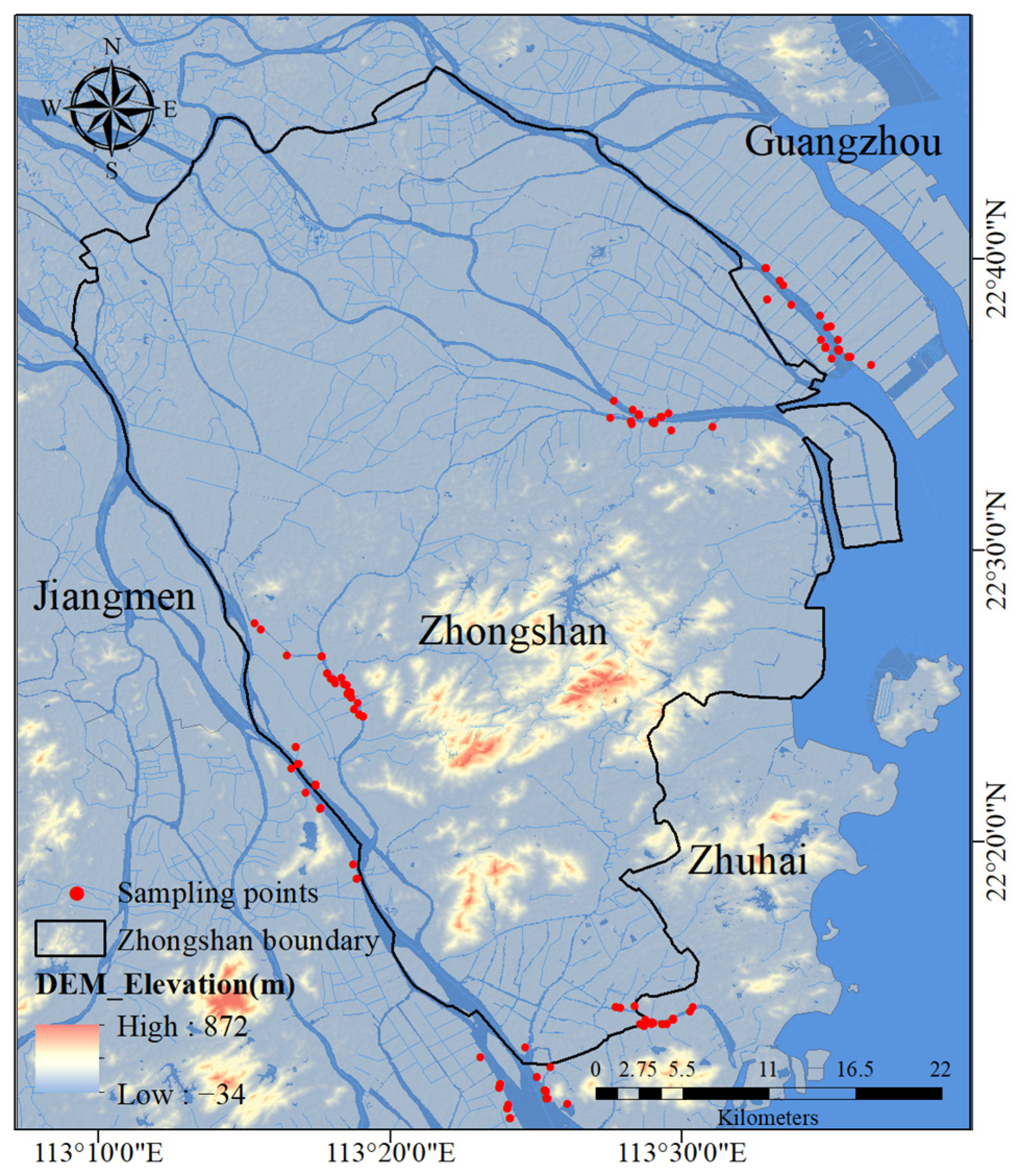
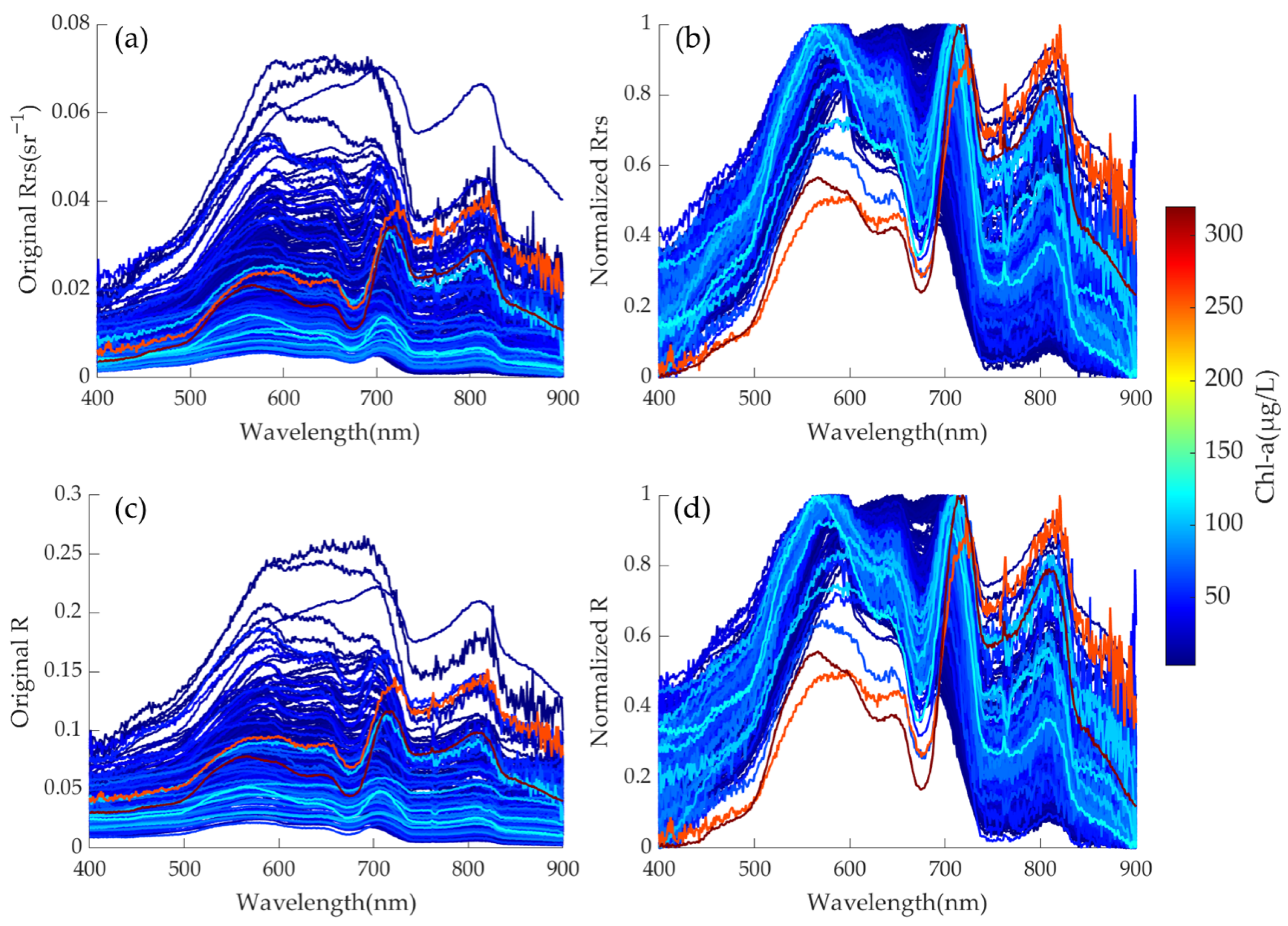
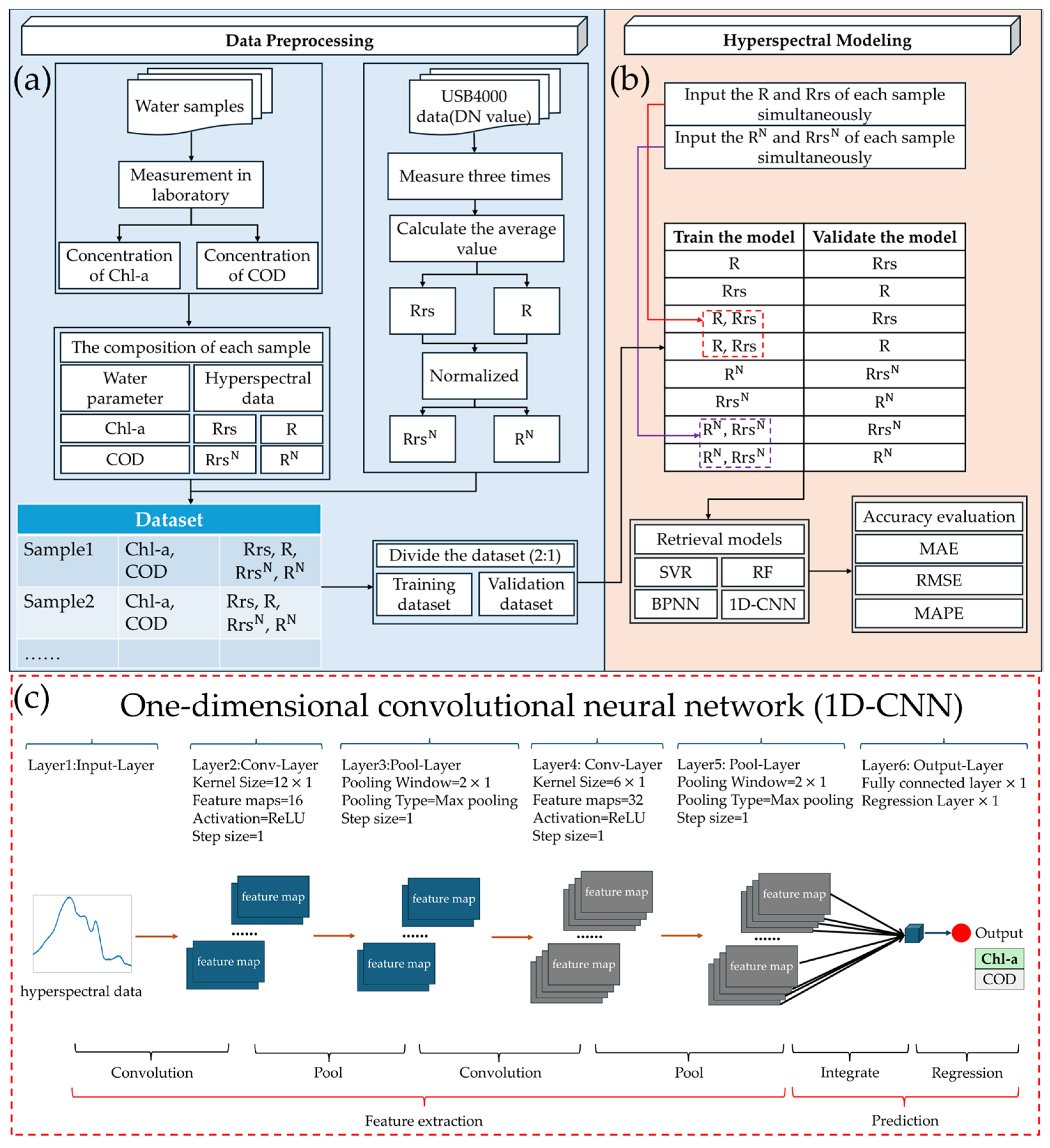

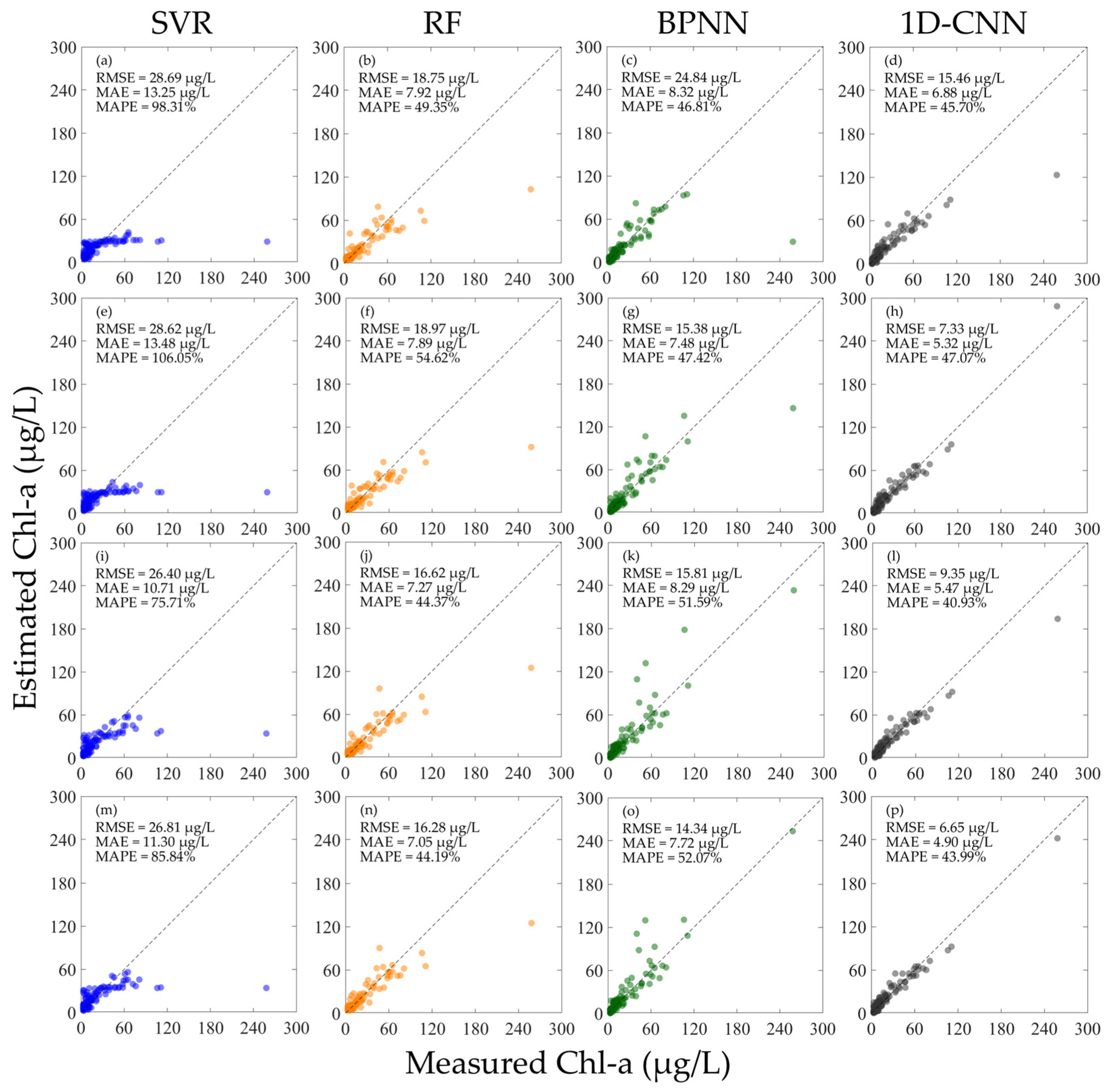
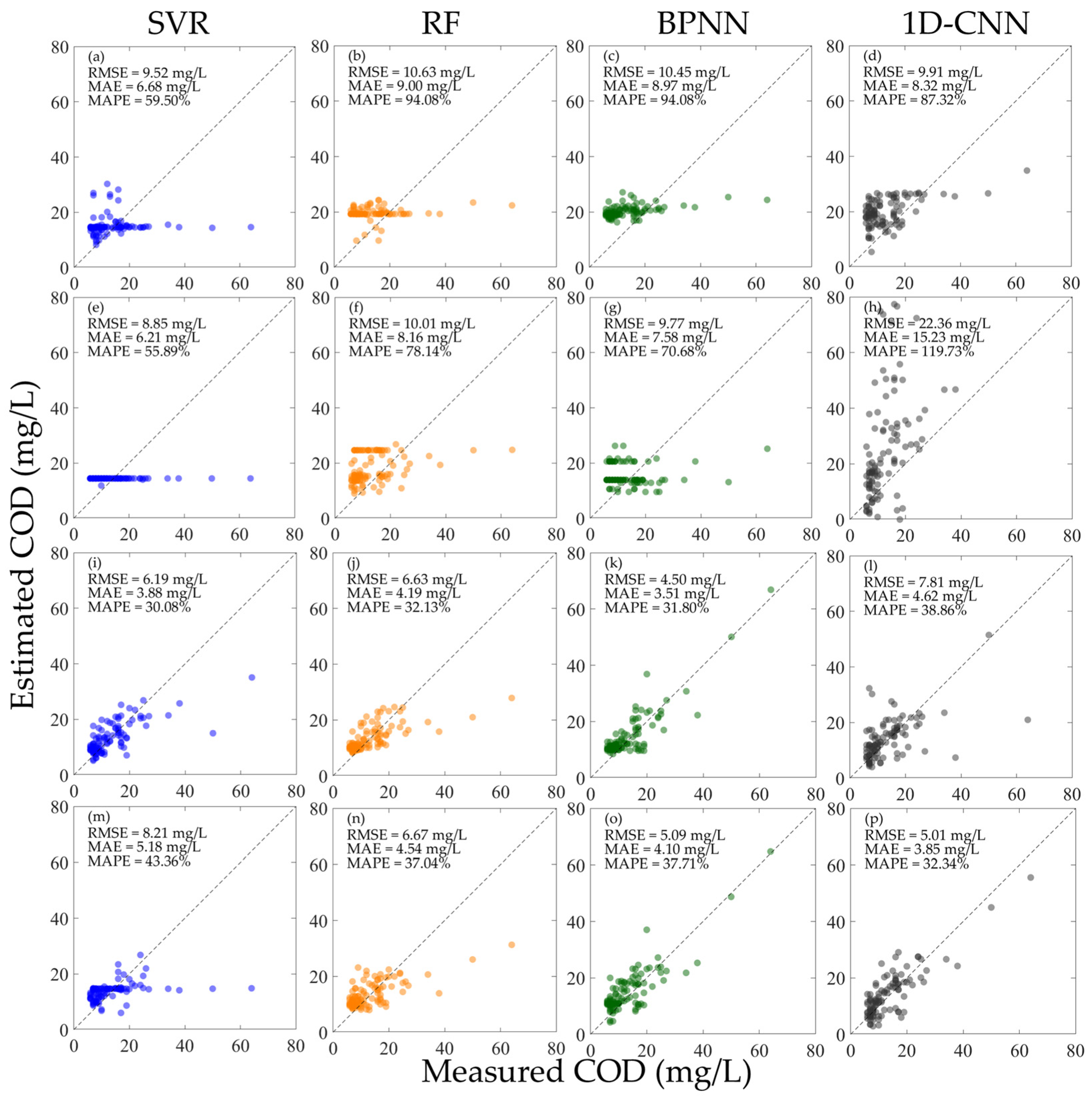
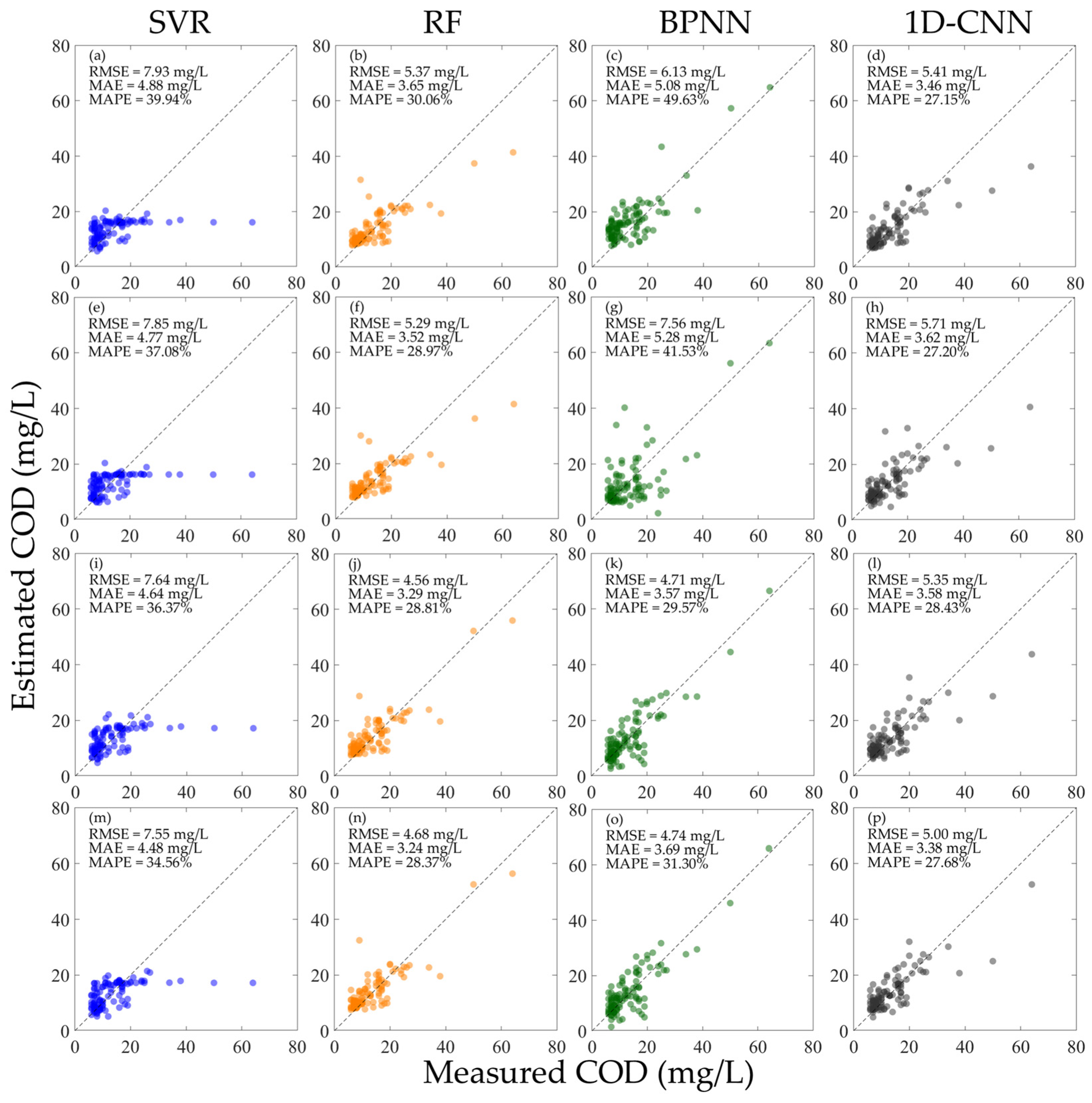

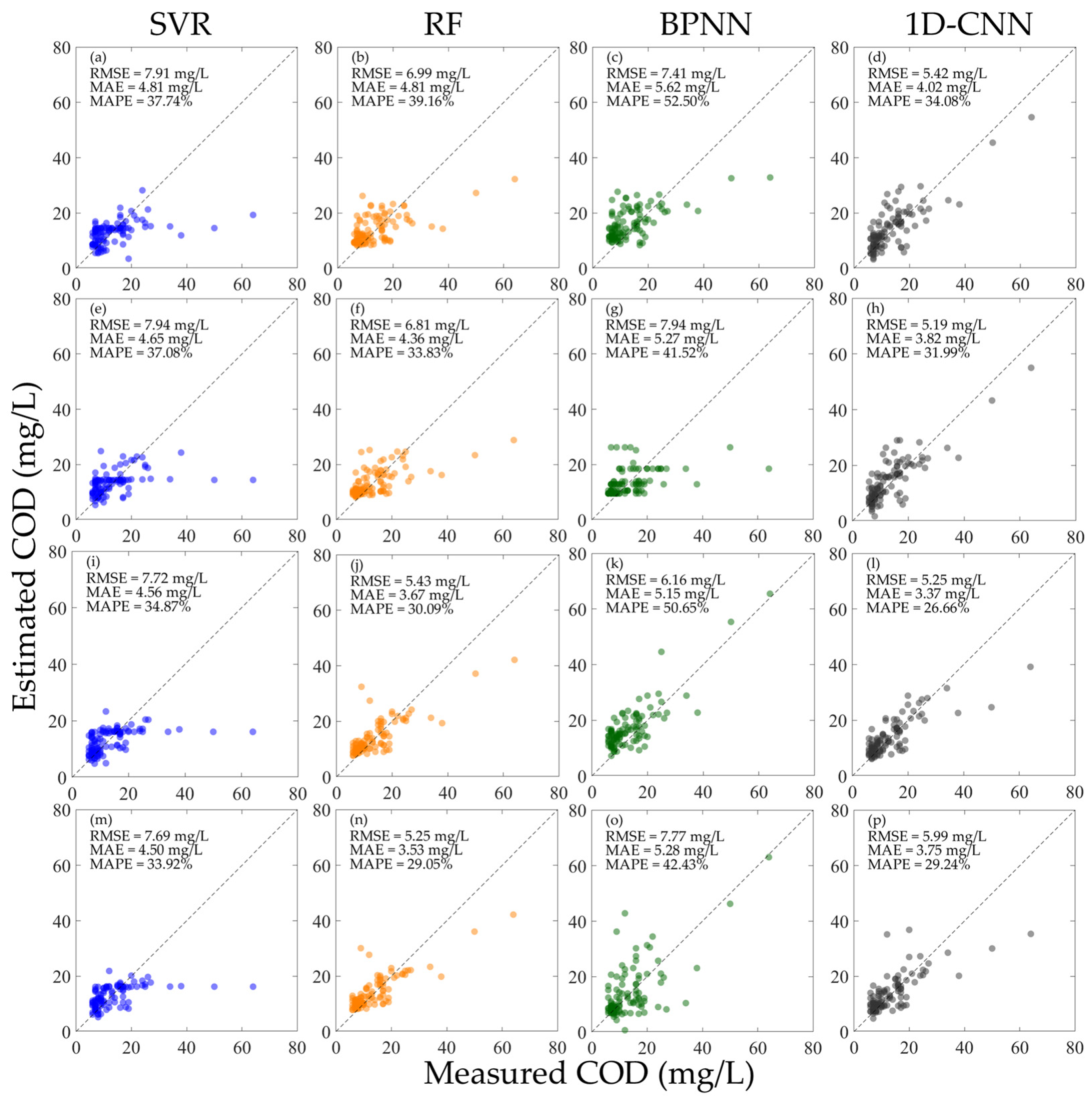
| Parameter | Minimum | Maximum | Average | Standard Deviation |
|---|---|---|---|---|
| Chl-a (µg/L) | 3 | 320 | 22.42 | 31.22 |
| COD (mg/L) | 5 | 72 | 13.30 | 8.76 |
Disclaimer/Publisher’s Note: The statements, opinions and data contained in all publications are solely those of the individual author(s) and contributor(s) and not of MDPI and/or the editor(s). MDPI and/or the editor(s) disclaim responsibility for any injury to people or property resulting from any ideas, methods, instructions or products referred to in the content. |
© 2025 by the authors. Licensee MDPI, Basel, Switzerland. This article is an open access article distributed under the terms and conditions of the Creative Commons Attribution (CC BY) license (https://creativecommons.org/licenses/by/4.0/).
Share and Cite
Guan, R.; Hou, Y.; Arif, M.; Xing, Q. Inverting the Concentrations of Chlorophyll-a and Chemical Oxygen Demand in Urban River Networks Using Normalized Hyperspectral Data. Sensors 2025, 25, 7004. https://doi.org/10.3390/s25227004
Guan R, Hou Y, Arif M, Xing Q. Inverting the Concentrations of Chlorophyll-a and Chemical Oxygen Demand in Urban River Networks Using Normalized Hyperspectral Data. Sensors. 2025; 25(22):7004. https://doi.org/10.3390/s25227004
Chicago/Turabian StyleGuan, Rongda, Yingzhuo Hou, Maham Arif, and Qianguo Xing. 2025. "Inverting the Concentrations of Chlorophyll-a and Chemical Oxygen Demand in Urban River Networks Using Normalized Hyperspectral Data" Sensors 25, no. 22: 7004. https://doi.org/10.3390/s25227004
APA StyleGuan, R., Hou, Y., Arif, M., & Xing, Q. (2025). Inverting the Concentrations of Chlorophyll-a and Chemical Oxygen Demand in Urban River Networks Using Normalized Hyperspectral Data. Sensors, 25(22), 7004. https://doi.org/10.3390/s25227004





